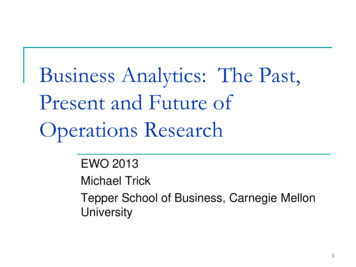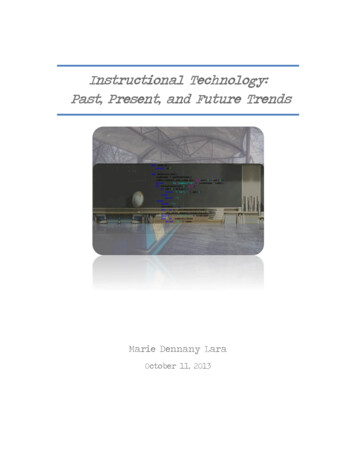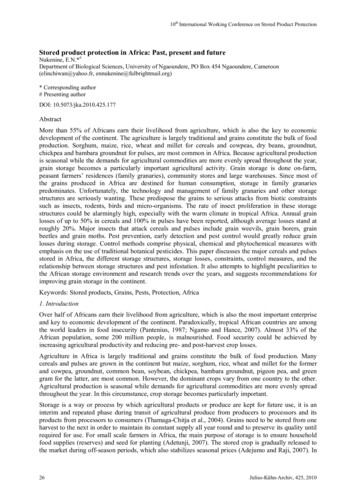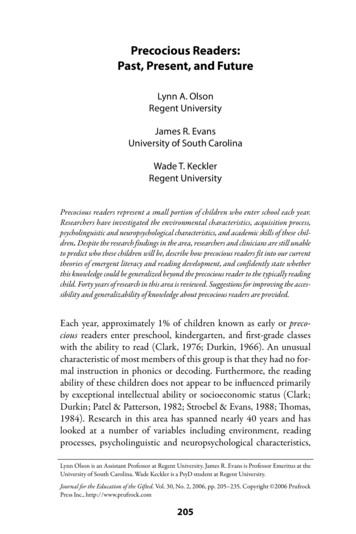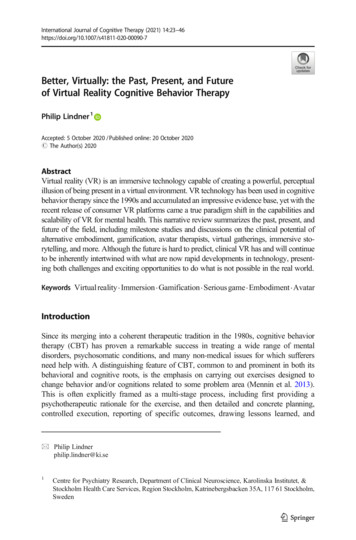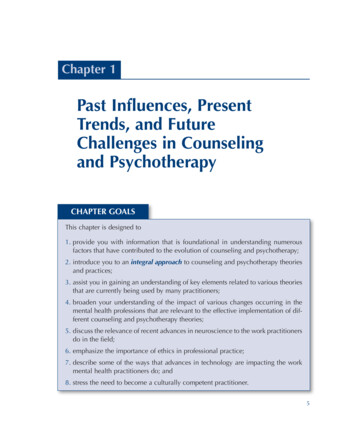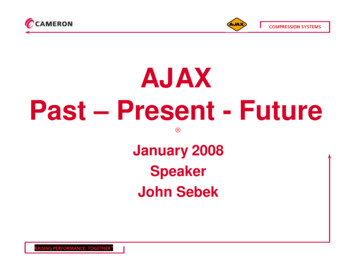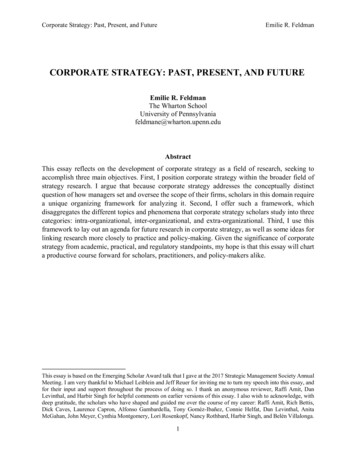
Transcription
Corporate Strategy: Past, Present, and FutureEmilie R. FeldmanCORPORATE STRATEGY: PAST, PRESENT, AND FUTUREEmilie R. FeldmanThe Wharton SchoolUniversity of Pennsylvaniafeldmane@wharton.upenn.eduAbstractThis essay reflects on the development of corporate strategy as a field of research, seeking toaccomplish three main objectives. First, I position corporate strategy within the broader field ofstrategy research. I argue that because corporate strategy addresses the conceptually distinctquestion of how managers set and oversee the scope of their firms, scholars in this domain requirea unique organizing framework for analyzing it. Second, I offer such a framework, whichdisaggregates the different topics and phenomena that corporate strategy scholars study into threecategories: intra-organizational, inter-organizational, and extra-organizational. Third, I use thisframework to lay out an agenda for future research in corporate strategy, as well as some ideas forlinking research more closely to practice and policy-making. Given the significance of corporatestrategy from academic, practical, and regulatory standpoints, my hope is that this essay will charta productive course forward for scholars, practitioners, and policy-makers alike.This essay is based on the Emerging Scholar Award talk that I gave at the 2017 Strategic Management Society AnnualMeeting. I am very thankful to Michael Leiblein and Jeff Reuer for inviting me to turn my speech into this essay, andfor their input and support throughout the process of doing so. I thank an anonymous reviewer, Raffi Amit, DanLevinthal, and Harbir Singh for helpful comments on earlier versions of this essay. I also wish to acknowledge, withdeep gratitude, the scholars who have shaped and guided me over the course of my career: Raffi Amit, Rich Bettis,Dick Caves, Laurence Capron, Alfonso Gambardella, Tony Goméz-Ibañez, Connie Helfat, Dan Levinthal, AnitaMcGahan, John Meyer, Cynthia Montgomery, Lori Rosenkopf, Nancy Rothbard, Harbir Singh, and Belén Villalonga.1
Corporate Strategy: Past, Present, and FutureEmilie R. FeldmanINTRODUCTIONCorporate strategy is a subject of major academic significance and practitioner importancein the modern business environment. From an academic standpoint, one of Rumelt, Schendel, andTeece’s (1991, 1994) four canonical questions in strategy research gets at the heart of this topic:“What is the function of or value added by the headquarters unit in a multi-business firm?.Or,what limits the scope of the firm?” (Rumelt et al., 1994: 44). These questions date back at least toChandler’s (1962) seminal work, in which he argued that the administrative structures within fourlarge corporations (General Motors, Sears, Standard Oil of New Jersey, and DuPont) adapted toaccommodate and promote the growth and development of these multi-business organizations.Since then, scholars in strategy and corporate finance have spent decades seeking to understandhow corporate structures and the managers that oversee them can add value to or destroy value intheir constituent businesses. However, as Rumelt et al. (1994: 3) note, the multi-business firm is aresearch topic that belongs more to strategy than to any other field of study, since “in suchorganizations there is a level of management activity that deals with integrating the variousdivisions or businesses that make up the firm.”From a practitioner perspective, moreover, corporate scope decisions, such as mergers andacquisitions, alliances, and divestitures, have the potential to create or destroy enormous amountsof shareholder value, to significantly impact operating performance for better or for worse, and toimpose major organizational consequences on companies. As such, these kinds of decisions areoften key discussion points in top management team meetings and in corporate boardrooms.Oftentimes, however, the outcomes of the corporate strategy decisions that companies make fallfar short of expectations, 1 or worse, fail to solve the underlying problems that motivated them inOne well-cited piece of conventional wisdom that supports this point is the remark that two-thirds of M&A fail tocreate value for the companies that undertake those deals.12
Corporate Strategy: Past, Present, and FutureEmilie R. Feldmanthe first place, at least in part because those underlying “wicked” problems are poorly-structured,if they are even articulated at all (Camillus, 2008; Baer, Dirks, and Nickerson, 2013; Nickersonand Argyres, 2018; Csaszar, 2018). Perhaps in consequence, entire industries, such as managementconsulting and investment banking, have been built around demand for advice on whether, when,and how to execute corporate strategy transactions, as well as how to manage their financial andorganizational implementation and consequences. Additionally, most business schools offer atleast one (and very often more than one) course on corporate strategy, mergers and acquisitions,or both. This suggests that there is clearly demand for research insights and content on corporatestrategy among the current and next generations of strategy and management practitioners.The clear importance of corporate strategy to researchers and practitioners alike is reflectedin the prevalence of publications on this topic. Figure 1 and Table 1 present a Web of Scienceanalysis of the relative share of publications in the Strategic Management Journal, the top journalin the field of strategy, whose titles contain at least one keyword (or variant thereof) relating tocorporate strategy. 2 While there is much year-to-year cyclicality in the relative prevalence ofpublications on corporate strategy topics, overall, there is a clear upwards trend in the researchattention that is paid to them. Indeed, the average percentage of corporate strategy-related articleswent from about 10% in the 1980-1989 decade to nearly 40% in the years since then.-----Figure 1 and Table 1 here----Drawing on the foregoing discussion and analysis, this essay seeks to accomplish threemain goals. First, given Rumelt et al.’s (1994) arguments about the importance of corporatestrategy as a research topic, I seek to provide some insights about how corporate strategy fits intothe field of strategy. Second, given the unique features that I am able to surface in the coreThese keywords (presented with their variants) are the following: diversifi*, merg*, acqui*, M&A, divest*, assetsale, spinoff, spin-off, selloff, sell-off, scope, firm boundar*, corporate strategy, corporate scope, ally, or alliance*.23
Corporate Strategy: Past, Present, and FutureEmilie R. Feldmanquestions that animate research in corporate strategy, I present a three-part framework aimed atorganizing the different topics and phenomena that corporate strategy scholars study. Thisframework is especially important in view of the consistently strong and growing representationof corporate strategy as a domain for research inquiry, as well as the need to add greater structureto the problems that corporate strategy seeks to address and more rigor to the decision-makingprocesses that guide the selection and implementation of solutions to these problems. Third, andfurther to the previous points, I use my framework to lay out an agenda for some productivedirections that research in corporate strategy might take, as well as some ideas for linking corporatestrategy research more closely to practice and policy-making.WHAT IS CORPORATE STRATEGY?Research in strategy is fundamentally concerned with explaining what enables firms toenjoy sustainable performance advantages over their competitors. One of the most importantdebates in this field emerged between scholars rooted in the tradition of industrial organizationeconomics (IO) and scholars involved in the development of the resource-based view of the firm(RBV). For the IO-oriented scholars, Bain’s structure-conduct-performance paradigm (Bain,1956) informed the idea that industry structure and firms’ (or businesses’) positions therein arekey determinants of their relative performance (Porter, 1979, 1980). By comparison, for scholarscoming from the RBV tradition, differences in performance are driven by the idiosyncratic andinimitable resources and capabilities that companies have at their disposal (Penrose, 1959; Rumelt,1974, 1982; Wernerfelt, 1984; Barney, 1986; Dierickx and Cool, 1989). The tension between thesetwo perspectives was reflected in a series of variance decomposition studies, in which scholarsfrom the IO tradition tended to find evidence of a more significant industry effect than a businessunit effect on firm performance (Schmalensee, 1985; Wernerfelt and Montgomery, 1988;4
Corporate Strategy: Past, Present, and FutureEmilie R. FeldmanMcGahan and Porter, 1997), while scholars from the RBV tradition tended to find evidence of amore significant business unit effect than an industry effect on firm performance (Rumelt, 1991;Bowman and Helfat, 2001; Adner and Helfat, 2003).In some sense, this early debate between scholars rooted in the IO and RBV perspectivesdivided the field of strategy into two parts, competitive strategy and corporate strategy, whichfocus on distinct core questions. On the one hand, research in competitive strategy is animatedaround analyzing how markets, resources, technologies, and organization might explaindifferences in firm performance. Various theories were applied and frameworks were developedto address how these kinds of factors influence firm performance (Caves and Porter, 1977; Porter,1980; Ghemawat, 1991, 1997; Brandenburger and Stuart, 1996, 2007; Lippman and Rumelt,2003). On the other hand, however, research in corporate strategy seeks to address a different corequestion: how do managers set and oversee the scope of their firms—that is, how do managersdetermine which businesses belong within their firms and which do not, what transactions (likeM&A, alliances, or divestitures) do they undertake to achieve that scope, how do they allocateresources among their constituent businesses, and how do they coordinate or promoteinterdependencies across those businesses? Differences in firm performance are important tocorporate strategy inasmuch as they serve as an outcome—ideally, the decisions that the managerof a firm makes in response to the above-mentioned questions lead that company to enjoy betterperformance than its competitors. But, ultimately, answering questions around how managers setand oversee the scope of their firms is the core objective of corporate strategy research.Interestingly, despite the wealth of research that has sought to answer this question, as well as themultiplicity of theories that have been invoked to conceptualize those answers, no framework yet5
Corporate Strategy: Past, Present, and FutureEmilie R. Feldmanexists to organize and add structure to the different topics and phenomena that scholars in this fieldstudy. I take up the task of offering such a framework in the next subsection of this essay.A FRAMEWORK FOR CORPORATE STRATEGYThe answer to the question of “how do managers set and oversee the scope of their firms?”can be broken down into three key components: the first is that managers coordinate resourceswithin the boundaries of their firms, the second is that managers coordinate relationships withother companies across the boundaries of their firms, and the third is that managers decide whichbusinesses belong within the boundaries of their firms and which ones do not. Thus, thisframework of how managers set and oversee firm scope can be viewed as telescoping, in that theseactions range from intra-organizational to inter-organizational to extra-organizational. Figure 2depicts these three levels of managerial action visually, emphasizing the point that each of themoffers a distinct locus of engagement vis-à-vis the focal firm. Additionally, Table 2 presents thetheories that are commonly used to elucidate these three categories of managerial action. I willnow describe the components of this framework in greater detail.-----Figure 2 and Table 2 here----Intra-Organizational ActionsStarting with the intra-organizational standpoint, the first answer to the question of “howdo managers set and oversee the scope of their firms?” is that they must coordinate how resourcesare utilized and deployed within the boundaries of their firms. This can encompass a number ofdifferent actions, including deciding how to allocate resources to productive uses (Chandler, 1962;Bower, 1970; Christensen and Bower, 1996; Sull, 1999; Gilbert, 2001; Bardolet, Lovallo, andRumelt, 2010; Arrfelt, Wiseman, and Hult, 2013; Arrfelt et al., 2015), determining how to leveragecertain resources across multiple business units to promote synergies and interdependencies6
Corporate Strategy: Past, Present, and FutureEmilie R. Feldman(Penrose, 1959; Leonard-Barton, 1992; Teece et al., 1994; Chang, 1996; Capron, Dussauge, andMitchell, 1998; Helfat and Eisenhardt, 2004; Levinthal and Wu, 2010; Wu, 2013; Sakhartov andFolta, 2014), and choosing whether and how to pursue cross-subsidization in internal capitalmarkets (Jensen, 1986; Stein, 1997; Scharfstein and Stein, 2000; Khanna and Tice, 2001; Billettand Mauer, 2003; Ozbas and Scharfstein, 2009). Given the nature of these actions, two theoreticalperspectives that are informative in depicting how managers make these kinds of decisions aredynamic capabilities and resource redeployment. Notably, because managers can choose toadvance their own self-interests in making intra-organizational resource allocation decisions,agency theory can also provide useful theoretical grounding for these issues.Dynamic capabilities are defined as “a firm’s ability to integrate, build, and reconfigureinternal and external competences to address rapidly changing environments” (Teece, Pisano, andShuen, 1997). Diversified firms are fertile ground in which to study dynamic capabilities becausemanagers must decide whether and how to apply key capabilities across their componentbusinesses, and determine what the consequences of doing so (or not) might be. For example,Levinthal and Wu (2010) distinguish between scale-free (Anand and Singh, 1997; Teece, 1982;Winter and Szulanski, 2001) and non-scale-free (Capron, 1999; Helfat and Eisenhardt, 2004;Teece, 1980) capabilities, arguing that the latter impose opportunity costs when managers try toleverage them across businesses within diversified firms (Wu, 2013). Similarly, both Feldman(2014) and Natividad and Rawley (2016) find evidence that legacy divestitures are associated witha decline in the operating performance of the divesting firms, attributable to the dissipation of corecapabilities that were accumulated over time in those companies’ original (legacy) businesses.In a similar vein, the literature on resource redeployment seeks to understand the value ofmanagers having the flexibility to internally redistribute non-financial resources across the7
Corporate Strategy: Past, Present, and FutureEmilie R. Feldmancomponent businesses of multi-business firms (Anand and Singh, 1997; Belderbos, Tong, and Wu,2014; Lieberman, Lee, and Folta, 2017; Miller and Yang, 2016; O’Brien and Folta, 2009;Sakhartov and Folta, 2014; Wu, 2013). Diversified firms are again a critical context in which toinvestigate this issue, since business units are the locus of redistribution. This stream of researchraises an important distinction between intra-temporal economies of scope (also known assynergies), in which managers contemporaneously share key resources across their businesses, andinter-temporal economies of scope, in which managers choose how to reallocate resources acrosstheir business units over time (Helfat and Eisenhardt, 2004; Levinthal and Wu, 2010; Sakhartovand Folta, 2014, 2015). This literature therefore introduces a dynamic rather than a static view offirm scope.The common theme that emerges from the literatures on dynamic capabilities and resourceredeployment is that the key intra-organizational action that managers must take is to deliberatelyand proactively leverage the stocks of resources and capabilities that exist within their firms, bothover time and especially in the face of rapidly changing environmental conditions. Importantly,though, managers may not always pursue the best interests of their firms in making these kinds ofdecisions, at times instead seeking to advance their own priorities and pet projects. For example,managers may inefficiently cross-subsidize or over-invest in certain preferred businesses at theexpense of other ones (Berger and Ofek, 1995; Lamont, 1997; Scharfstein and Stein, 2000; Rajan,Servaes, and Zingales, 2000; Ozbas and Scharfstein, 2009). Nevertheless, despite the morenegative outcomes that may occur in these kinds of circumstances, the underlying intraorganizational function of managers coordinating how resources are utilized and deployed withinthe boundaries of their firm remains the same.8
Corporate Strategy: Past, Present, and FutureEmilie R. FeldmanInter-Organizational ActionsTurning next to the intra-organizational standpoint, a second answer to the question of“how do managers set and oversee the scope of their firms?” is that they must coordinaterelationships with other companies across the boundaries of their firms. This, too, can encompassa number of different actions, especially developing inter-organizational routines with (Dyer andSingh, 1998; Kale, Dyer, and Singh, 2002; Lavie, 2006) and learning from other firms (Cohen andLevinthal, 1990; March, 1991; Lane and Lubatkin, 1998). As such, the two theoretical perspectivesthat are useful in conceptualizing how managers make these kinds of decisions are the relationalview and network theory.The relational view holds that unique combinations of resources or capabilities that arebrought together by transaction partners, especially alliance partners, can lead to supra-normalprofits (Dyer and Singh, 1998). These combinations are often called relational capabilities, andthey can serve as important sources of learning and knowledge accumulation, especially as itpertains to future interactions between managers (Rosenkopf and Nerkar, 2001; Kale et al., 2002;Lavie, 2006; Kale and Singh, 2007; Gulati, Lavie, and Singh, 2009). By emphasizing the dyadicnature of inter-firm relationships (Dyer and Singh, 1998), the relational view therefore stands incontrast to both the IO paradigm (which, as described earlier, holds that firms derive supra-normalprofits from the industries in which they operate and their positions in them (Porter, 1979, 1980))and the RBV perspective (which holds that firms derive supra-normal profits from theiridiosyncratic resource positions (Penrose, 1959; Rumelt, 1974, 1982; Wernerfelt, 1984; Barney,1986; Dierickx and Cool, 1989)).Extending these points, network theory reveals that ties between companies, especiallytheir alliance partners, can be a key source of strategic knowledge and learning, and therefore,9
Corporate Strategy: Past, Present, and FutureEmilie R. Feldmanvalue creation (Gulati and Singh, 1998; Gulati, Nohria, and Zaheer, 2000). Accordingly, not onlydo organizations learn from their managers’ accumulated experiences, but they also learn fromtheir repeated interactions with their counterparties (Gulati, 1999; Kale, Singh, and Perlmutter,2000; Inkpen and Tsang, 2005). For example, acquiring firms that have a prior alliance relationshipwith the target they are buying tend to outperform those that do not (Porrini, 2004), especially ininternational contexts (Zaheer, Hernandez, and Banerjee, 2010), and firms that accumulate moreacquisition experience tend to outperform those that have less experience (Barkema and Schijven,2008; Haleblian and Finkelstein, 1999; Finkelstein and Haleblian, 2002; Haspeslagh and Jemison,1991). Furthermore, a recent stream of research in this domain suggests that acquisitions can beconceptualized as “shocks” that collapse nodes within
Corporate strategy is a subject of major academic significance and practitioner importance in the modern business environment. From an academic standpoint, one of Rumelt, Schendel, and Teece’s (1991, 1994) four canonical questi
